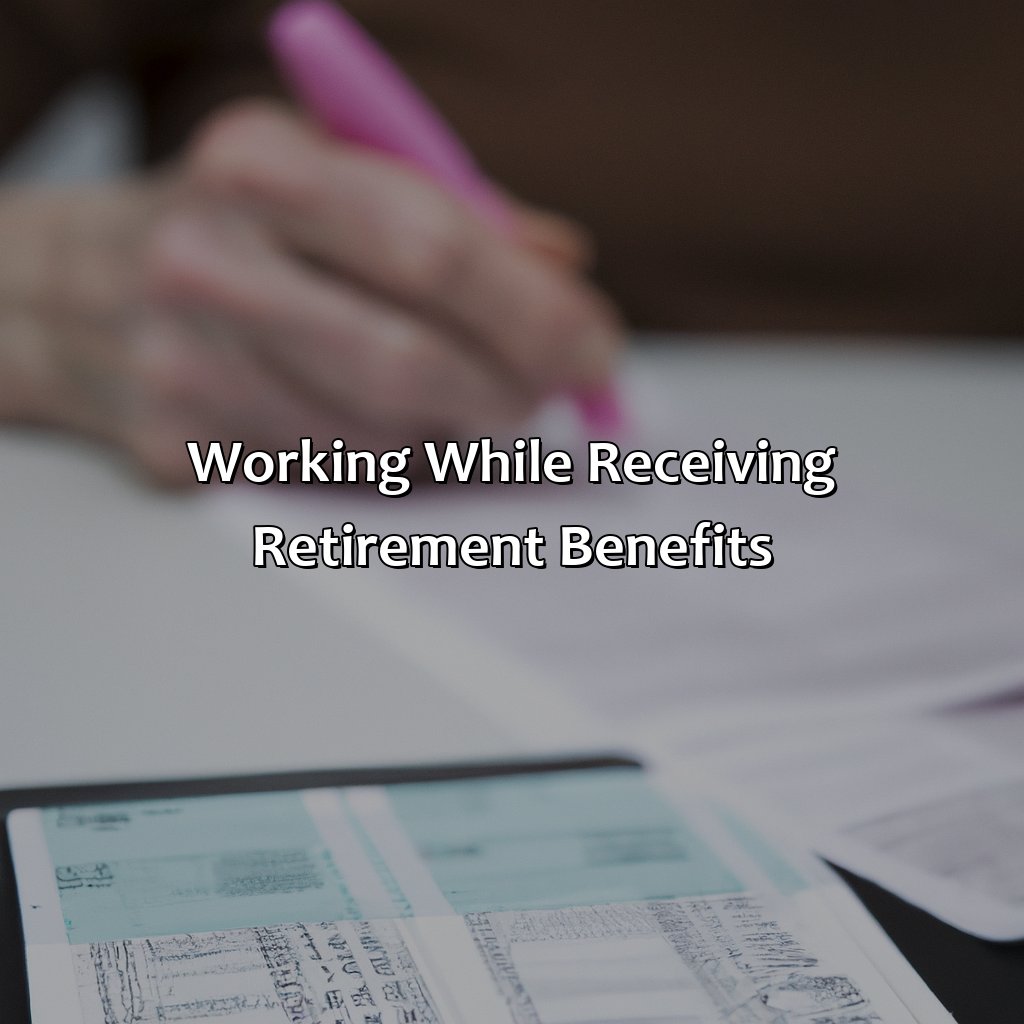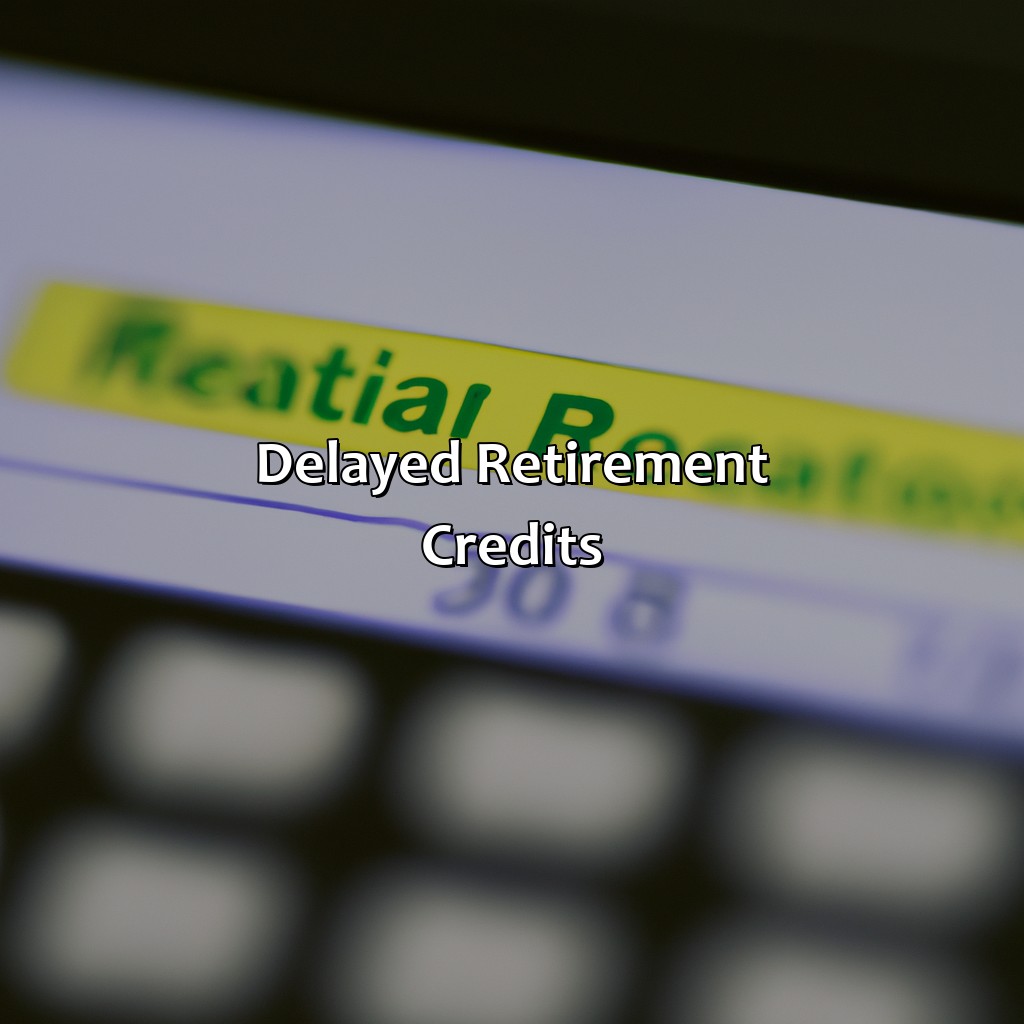What Will My Social Security Be When I Retire?
Key Takeaway:
- Calculating your Social Security retirement benefit uses your Primary Insurance Amount (PIA), which is based on your earnings history. Your PIA can be affected by factors such as your age, income, and retirement age, so it’s important to understand how these factors impact your benefit.
- If you work while receiving retirement benefits, your benefit may be reduced if you earn above a certain limit. However, there are certain exceptions and adjustments that can be made to help reduce the impact of this reduction in benefits.
- Delayed retirement credits can be earned if you wait to claim your retirement benefits, resulting in a higher monthly benefit. This can also affect your survivor’s benefits. However, early retirement can result in a reduction of benefits and should be carefully considered.
- It’s important to regularly review your Social Security statement for accuracy and to ensure that you understand how your benefits are calculated and how certain choices can impact your benefit amount.
Are you concerned about what will be your financial security when it’s time to retire? Knowing the basics of social security can help you plan for a comfortable retirement. You can find out what your social security will be when you retire.
Social Security Retirement Benefit Calculation
You must know your Primary Insurance Amount (PIA) to calculate your social security retirement benefit. Let’s explore the factors which influence this PIA. Plus, the adjustments that can be made to it.

Image credits: retiregenz.com by Joel Washington
Primary Insurance Amount (PIA)
The pivotal amount that determines the retirement benefits received from Social Security is based on a complex calculation called PIA. It is a monthly amount determined by your average lifetime earnings, taking into account inflation. The higher the PIA, the higher will be your monthly benefit payouts.
Your PIA may be affected by factors such as your earnings history, life expectancy, and whether or not you’ve made any deals with the devil.
Factors affecting PIA
The amount of Social Security retirement benefits one is eligible for is determined by a formula known as the Primary Insurance Amount (PIA). The PIA calculation takes into account various factors such as an individual’s average indexed monthly earnings, their work history, and the age at which they choose to begin receiving benefits. Additional variables like cost of living adjustments and taxation can also impact benefit amounts.
Importantly, those who earn more over their working lifetime will generally receive higher PIA than those with lower incomes. Eligibility requirements and factors impacting PIA can be complex but are important considerations for planning financial stability in later years.
It should also be noted that certain professions like military service members have their own unique benefit calculations and entitlements.
According to the Social Security Administration, around 65 million people were receiving some type of Social Security benefits in 2020.
Get ready to adjust your expectations (and your pocketbook) because it’s time to talk about PIA.
Adjustments to PIA
The elements that modify a Primary Insurance Amount (PIA) can have both positive and negative effects, leading to an individual’s final Social Security benefit. These modifications are inclusive of the years of earnings records, cost-of-living adjustments for wages prior to age 60, and optional Early Retirement Reduction Factors (ERRFs).
These ERRFs become more common when one is looking to retire at a younger age than what is accepted under the Social Security scheme. Accepting these ERRFs can mean a permanent cut in the monthly benefits you receive under Social Security. Hence, it’s essential to weigh all options before accepting these factors.
Other modifications that impact one’s total benefit amount are events like re-entering the workforce after collecting benefits or earning more than previous years towards retirement. In addition, factors such as Medicare premium deductions from your monthly Social Security checks or receiving government pensions may also affect PIA.
It’s worth noting that there are no preset rules for how much any factor will adjust your PIA; thus, it’s best to consult with a financial planner or look for online tools provided by Social Security Administration (SSA) before deciding on a plan.
A close family member’s experience who eagerly looked forward to retirement but forgot about claiming delayed retirement credit. She later acknowledged how she should have waited until 70 instead of claiming early at 62 because waiting would have helped her increase her monthly benefit payments significantly as she aged throughout her golden years.
When it comes to retirement, working while receiving benefits is like trying to eat your cake and have it too – except the cake is your savings and the fork is the government.
Working While Receiving Retirement Benefits
You can keep working while getting retirement benefits. It’s part of the “Working While Receiving Retirement Benefits” section. There are sub-sections that provide solutions. These include:
- Earnings Limitations
- Reduction in Benefits
- Temporary Suspension of Benefits

Image credits: retiregenz.com by David Jones
Earnings Limitations
The rules for earning limitations while receiving retirement benefits are quite strict. One must not exceed the prescribed limit or face consequences. By ensuring adherence, individuals can receive their stipulated Social Security payments without any hassle.
It is important to note that each year, the Social Security Administration (SSA) establishes earning limitations that your earnings must fall under to still be eligible for Social Security benefits. These limits usually apply only before an individual reaches full retirement age, and after it, the earning limitations are relaxed.
If you go beyond this limit, the SSA will reduce your monthly payments by a specific amount per $1 earned over the limit – a situation that no one would want to face in retirement.
Furthermore, it must be noted that if you reach full retirement age, there are no longer any restrictions on how much income you can earn.
Many people fail to understand these nuances of earning limitations and end up losing out on lucrative benefits from social security during their earnings stage of life.
An interesting case is where some recipients find out after their retirement that they had been overpaid by Social Security. The reason behind this is their failure to enforce earnings restrictions correctly before retirement began in earnest – awareness about these restrictions is essential. Thus, understanding how earnings limitations work when receiving retirement benefits is critical to ensure a comfortable living in old age.
Retirement benefits are like a soufflé: one wrong move and the reduction in benefits can leave you feeling flat.
Reduction in Benefits
The impact of working while receiving retirement benefits is a reduction in the amount you receive. This can be explained through several scenarios:
- Retirees under full retirement age – for every $2 earned over the limit, their benefits are reduced by $1.
- Retirees in the year they reach full retirement age – for every $3 earned over the limit, their benefits are reduced by $1 until the day they reach full retirement age.
- Retirees who continue working after reaching full retirement age – Their earnings will not affect their Social Security benefits and no reduction applies.
- Retirees who take early retirement and work – social security reduces their benefit on an ongoing basis if they earn above a set limit; however, once they reach full retirement age, there’s no longer a reduction due to earning income.
It is important to note that some earnings do not count towards these reductions, such as pensions from jobs not subject to Social Security taxes. Retirees should also keep track of their monthly earnings to ensure the correct amount of Social Security payments are being made.
Pro Tip: Keeping track of your monthly earnings can help you avoid any surprises in reductions or adjustments to your Social Security benefit.
Why wait for retirement to get a taste of suspended benefits? Just try asking for a raise at work.
Temporary Suspension of Benefits
For a period, you can pause your social security benefits if you wish to work and get additional credits. This option is known as the ‘Benefits Suspension Program‘. If you plan to work and are eligible for retirement benefits, you can temporarily stop receiving payments and accumulate more significant retirement credits in your Social Security records.
However, there are some restrictions on when and how long you can suspend your payments. You cannot accept this program until Full Retirement Age (FRA), which depends on the year of your birth. If you have reached your FRA, then it will help if you cancel your suspension agreement within six months permanent.
It’s important to note that while suspending benefits, any family member of yours may also be affected who receives benefits based on their earnings record. Hence, consider the effects of temporarily suspending social security payment when deciding on working while receiving retirement benefits. The best suggestion would be to consult with a social security advisor before making any decisions. A knowledgeable person will make sure that you understand all the ins-and-outs of working in tandem with receiving retirement payments. Also, they’ll guide you through making informed decisions based on planning factors like income source requirements and tax implications.
Waiting to retire may be painful, but those delayed retirement credits sure do make the financial band-aid sting less.
Delayed Retirement Credits
Maximize Social Security benefits and plan for retirement? Delayed Retirement Credits (DRC) can help. Learn how DRC works here. Discover the maximum monthly credit you can receive. Plus, find out the effect of DRC on survivor’s benefits.

Image credits: retiregenz.com by Harry Washington
How the Credits Work
Retirement Credits increase your Social Security benefits by a certain percentage if you postpone the starting date. The credit rate varies depending on the year you were born. For example, if you were born in 1943-1954, your credits are 8% per year for each year after full retirement age.
Moreover, if you continue to work and earn money while collecting Social Security benefits, it can also affect how much you receive. This is because an income limit may reduce your monthly benefit amount until you reach full retirement age. It’s important to carefully assess your financial needs and how much delaying retirement will impact them.
It’s worth knowing that it may be beneficial for some people to delay receiving their Social Security payments until after they reach full retirement age, as each month’s delay earns delayed retirement credits. These credits accumulate up to 8% annually which can boost monthly benefits even higher.
One example of this is a retired doctor named Dr. Smith who delayed his social security benefits for three years after reaching full retirement age at 66. By doing so he increased his monthly payment by more than $300 from $2200.to $2500 a month!
Get ready to retire in style, just don’t forget to thank Delayed Retirement Credits for helping you afford those fancy retirement socks.
Maximum Monthly Credit
The Maximum Monthly Credit refers to the additional income one can receive by delaying their social security benefits beyond Full Retirement Age. This is essentially an increase in their monthly benefit amount if they wait until age 70 to start claiming it.
The amount of the credit is based on a percentage increase of one’s primary insurance amount (PIA), which is calculated based on earnings history and the age at which they claim benefits. For those who start collecting at 62, the maximum monthly credit is 30%, for those who start at 66 it’s 32%, and for those who wait until 70 it’s 48%.
It’s important to note that any delay in claiming after age 62 will result in an increase to the benefit amount. However, once one reaches age 70, there is no further increase. Additionally, if one chooses to continue working while receiving social security benefits before reaching Full Retirement Age, their benefit amount may be reduced if they earn over a certain limit.
Overall, delaying retirement credits can have a significant impact on one’s retirement income and should be carefully considered when making decisions about when to claim social security benefits. As always, seeking advice from a financial professional can be helpful in determining when and how to claim these benefits.
For example, my uncle chose to delay his social security benefits until he turned 70 years old. At that point, he was able to collect the maximum monthly credit and has enjoyed a higher retirement income than if he had started claiming earlier. This decision allowed him more financial stability during his golden years.
Survivor’s benefits: ensuring that even in death, the government gets its cut.
Effect on Survivor’s Benefits
When you delay your retirement credits, it can also have an effect on the benefits that your survivors receive after you pass away. This is because the amount of survivor’s benefits is based on the amount of workers’ benefits. So, if you delay receiving your social security payments and increase the amount of your worker’s benefits, the amount of survivor’s benefits will also increase.
It is important to note that survivor’s benefits are only available to certain eligible family members, such as a spouse, children or dependent parents. The surviving spouse must also be at least 60 years old (or 50 if disabled) to qualify for survivor’s benefits.
If you decide to delay receiving your social security payments in order to increase both your own retirement benefits and the survivor’s benefits for your eligible family members, it could potentially provide more financial security for them in the future.
To ensure that you are making the best decision for yourself and your loved ones, it could be wise to speak with a financial advisor who can help guide you through the complexities of social security and retirement planning. By taking action now and strategically delaying retirement credits when appropriate, you may prevent potential regret or lost opportunities later on.
Retire early and you’ll have plenty of time to regret not waiting for those delayed retirement credits to kick in.
Early Retirement Reductions
Want to retire early? Social Security benefits can help! Let’s talk about the Early Retirement Reductions. Three key points:
- Age for Early Retirement
- Reduction Calculation
- Catch-Up Provision
Knowing these will help you plan your early retirement!

Image credits: retiregenz.com by Joel Washington
Age for Early Retirement
For those considering an early retirement, it’s important to understand how this decision will impact your social security benefits. The age at which you can retire and receive benefits ranges from 62 to 70, with reductions for retiring before the full retirement age of 66 or 67.
Retiring at age 62 will result in a permanent reduction of your social security benefits, potentially by as much as 30%. Conversely, if you wait until after the full retirement age, you can increase your benefit amount by up to 8% per year. It’s essential to consider these options carefully before making decisions about early retirement.
It’s worth noting that other factors beyond age may also affect your social security benefits, such as work history and marital status. These details can impact not only the amount but also the timing of payments. As such, it’s wise to speak with a financial advisor or social security representative about your personal situation to ensure that you make informed decisions.
A friend of mine retired at age 63 and was initially excited but quickly realized he hadn’t considered the potential impact on his social security checks. His reduced income resulted in a significant change in his lifestyle and standard of living. He advises others to carefully weigh all aspects before deciding when to retire.
Calculating reductions for early retirement is like trying to do math while blindfolded, with your hands tied, and a calculator missing half its buttons.
Reduction Calculation
Calculating the Reduction for an early retirement from Social Security benefits is complex. If you retire before Full Retirement Age, your benefits will be reduced by a percentage based on the number of months you retired early. This reduction is permanent, even when you reach full retirement age. The reduction formula means that your benefit at age 62 would be about 30 percent less than what it would be if you waited until your full retirement age.
It is essential to understand that there are two separate reductions in Early Social Security Benefits. One reduction applies to the overall benefit amount, while the other decrease relates to any increases for delayed retirement credits. For example, suppose someone retires at age 62 instead of waiting until their full retirement age of 67 to start taking benefits. In that case, they’ll get only 70% of what he or she would receive at full retirement age plus there will be no increases due to delayed retirement credits.
An individual’s Primary Insurance Amount may also affect how much their monthly social security payment will reduce if retiring early. Primary Insurance Amount is based on lifetime earnings and is how much an eligible worker could receive at full retirement age and not accounting for reductions due to early retiring before the defined Full Retirement Age.
According to AARP’s analysis of the Social Security Administration (SSA) data in September 2020, over six million new individuals received social security payments in 2019.
Looks like I’ll have to catch up on my retirement savings the same way I catch up on my Netflix shows: with a sense of urgency and a bag of popcorn.
Catch-Up Provision
Individuals who are over the age of 50 and have not saved enough for retirement may find the Catch-Up Provision helpful. This provision allows those aged 50 and above to contribute an additional amount to their retirement accounts beyond the limits set by law. The total contribution limit is dependent on the type of account, but Catch-Up contributions can make it easier for those approaching retirement to save more.
Many people do not realize that they need a substantial amount of money during their retirement years or how fast they can rack up savings on taxes owed while still working when they start later in life. With this in mind, using the Catch-Up Provision could help someone catch up to where they need to be after a late start.
Furthermore, individuals who use this provision must meet certain requirements before they can make such a contribution. For example, their account must already be eligible for regular contributions, and there may be contribution limits each year. To ensure maximum results, consult with a financial advisor or accountant to help find an option that works best under your circumstances.
Pro Tip: Always plan early because proactive measures will ensure financially stable retirements.
Get ready to face the sad reality of your financial situation- reading your Social Security statement is like looking into a financial funhouse mirror.
Social Security Statements
Want to know your retirement benefits? Access your Social Security Statement. This section explains how significant this statement is for estimating future benefits. First, we’ll look at how to access it. Then, we’ll check out its contents. Finally, we’ll review the accuracy of the info.

Image credits: retiregenz.com by Adam Washington
Accessing Statement
Discovering Your Social Security Future
Your Social Security statement provides insight into your future. You can access it online, by mail or phone. By entering the code from your mailed statement, you can create an account and view your statement online.
To view your personalized benefits at any time, go to the official Social Security website or call their toll-free number. You’ll need to enter your personal information, such as birthdate and Social Security number, to begin.
Payment credit decreases the early claiming of benefits when benefits are higher at full retirement age. Increases may be available if you continue working after filing, impacting overall benefits in later years. Stay informed.
Consider Jane’s story: Jane attempted to claim her Social Security benefits early only to learn that her payments would be reduced due to earlier claiming and continued employment income. She chose instead to wait until full retirement age and increased her lifetime benefit sum by over $100 per month with delayed filings.
Get ready to face the harsh truth about your retirement funds, as you dive into the exciting world of Social Security Statements.
Statement Contents
The social security statement reveals a plethora of information for retirement planning, answering your questions about the benefits you will receive when it comes time to retire.
- Primary Insurance Amount: This section displays an estimate of your monthly benefit payment at different retirement ages starting at age 62.
- Earnings Record: An important feature that summarizes your earnings record for credits in the Social Security system, which helps calculate your benefit amount and make corrections if necessary.
- Estimated Disability Benefits: If you were to become disabled before retiring, this section outlines your estimated disability benefits and other essential details.
Your Social Security statement is a principal tool in ensuring preparedness for retirement, but it’s equally important to plan for inflation as social security checks remain static over time.
To maximize your social security benefits, consider delaying claiming benefits until maximum retirement age, earning additional income before claiming by working past the age of 66 or spousal benefits. By understanding your social security statement contents and taking appropriate action, you can sustain financial stability during your golden years.
Review for Accuracy.
Accuracy Verification of Social Security Statements
To ensure your future financial stability, it is crucial to review your Social Security statements for accuracy. Make sure the earnings and work history recorded in the statement match your employment records to avoid discrepancies in your benefits.
Inaccurate reporting could result in less or more benefits than you are entitled to receive. A mistake made when calculating your life-long contribution to the program can cause errors in your statement. Therefore, it’s essential that you regularly check and review the earnings history section of your social security statement.
It would help if you also kept a record of your employment history securely. Reviewing this yearly with the Social Security Administration can prevent identity theft since social security numbers are frequently found on w2 forms.
Pro Tip: Remember that reviewing for accuracy is an integral part of planning for retirement and ensuring that you receive all eligible social security benefits.
Some Facts About Social Security Benefits When You Retire:
- ✅ The amount of your social security benefits when you retire is based on your average income over the course of your working years. (Source: Social Security Administration)
- ✅ You can start receiving social security benefits as early as age 62, but the longer you wait to claim, the higher your monthly benefit will be. (Source: AARP)
- ✅ Your social security benefits may be subject to federal income tax if your income exceeds a certain threshold. (Source: Investopedia)
- ✅ The Social Security Administration sends an annual statement to everyone over 60 years old detailing their estimated benefits. (Source: Kiplinger)
- ✅ Social Security benefits are adjusted every year to keep pace with inflation. (Source: Social Security Administration)
FAQs about What Will My Social Security Be When I Retire?
What is Social Security and how does it work?
Social Security is a governmental program that pays retirement, disability, and survivors’ benefits to eligible individuals. The amount of your Social Security benefit is based on your earned income throughout your working life.
How do I find out what my Social Security benefit will be?
You can create a mySocialSecurity account on the Social Security Administration website to view your estimated benefit amount based on your earnings record. You can also request a paper Social Security Statement by phone or mail.
What factors influence the amount of my Social Security benefit?
The amount of your Social Security benefit is based on your average indexed monthly earnings over your 35 highest-earning years, the age at which you start receiving benefits, and your work history.
When can I start receiving Social Security benefits?
You can start receiving Social Security retirement benefits as early as age 62, but your benefit amount will be reduced if you start before your full retirement age (typically between 66 and 67, depending on your birth year). However, if you delay receiving benefits until after your full retirement age, your benefit amount will increase.
Will my Social Security benefit be enough to support me in retirement?
This depends on your individual financial situation and how much you have saved for retirement. Social Security benefits are designed to supplement retirement income, not replace it entirely. It’s important to have additional sources of retirement income, such as personal savings or a pension.
Can I receive Social Security benefits if I keep working after I retire?
Yes, you can still receive Social Security retirement benefits if you keep working after you retire, as long as you have reached your full retirement age. However, if you start receiving benefits before your full retirement age and continue to work, your benefits may be reduced if you earn more than a certain amount.


